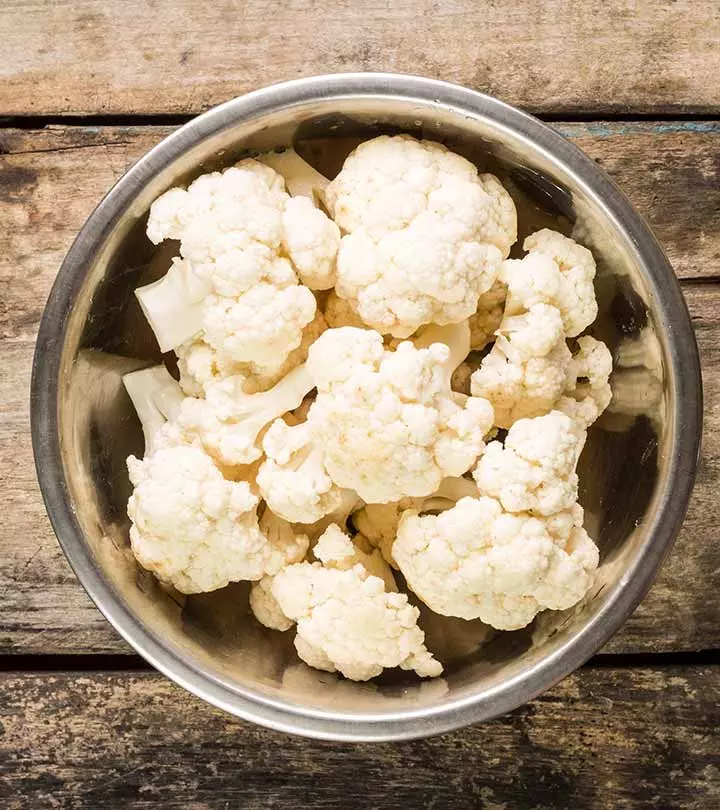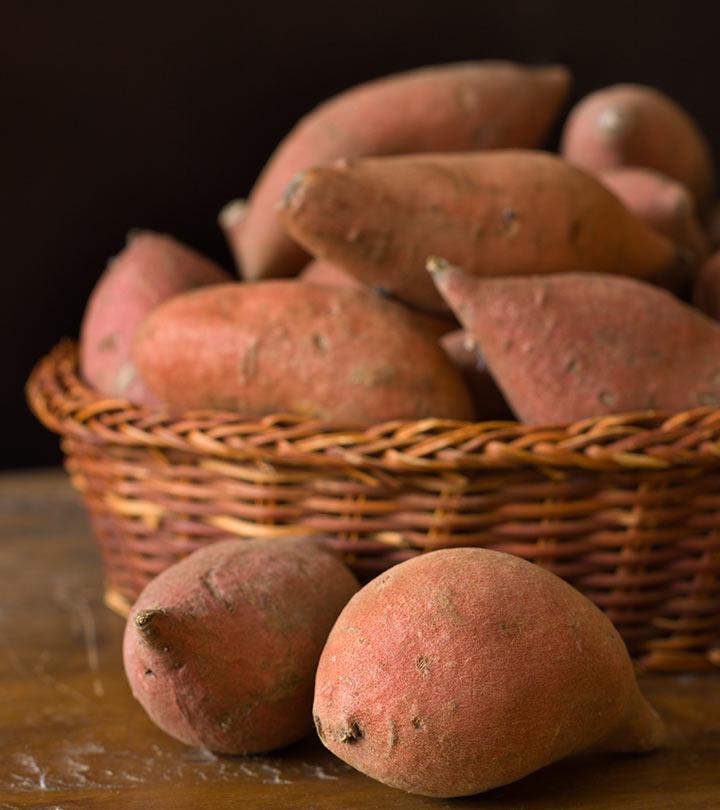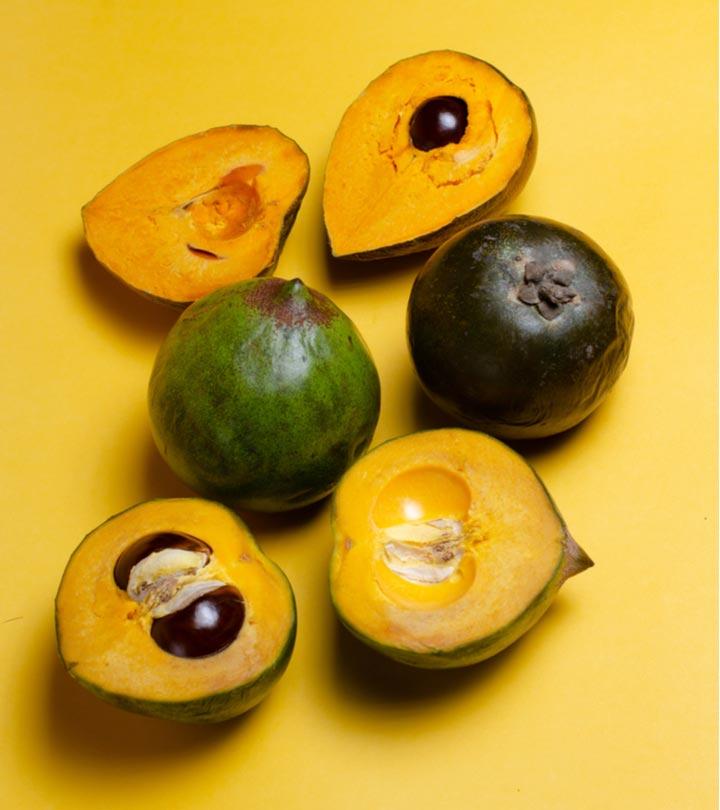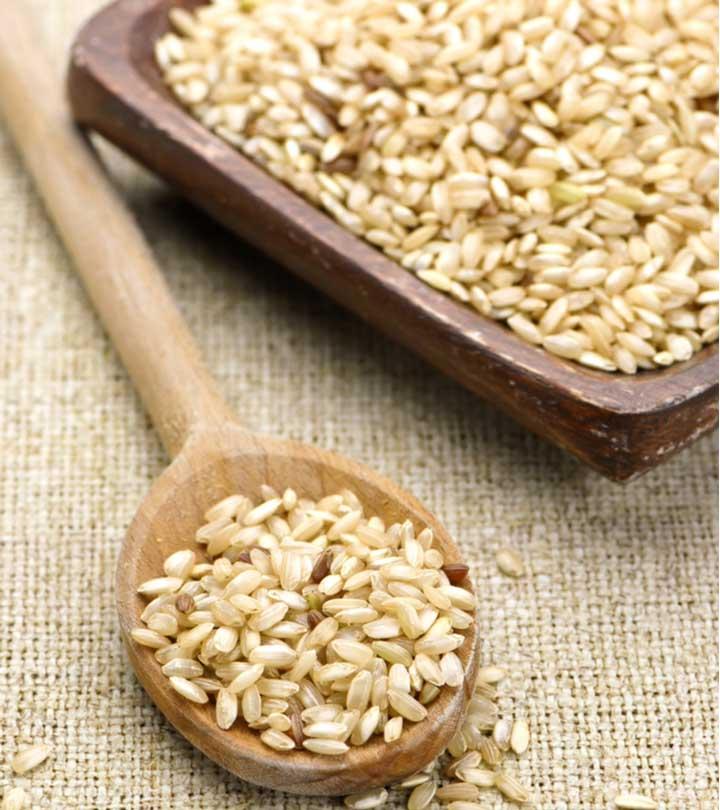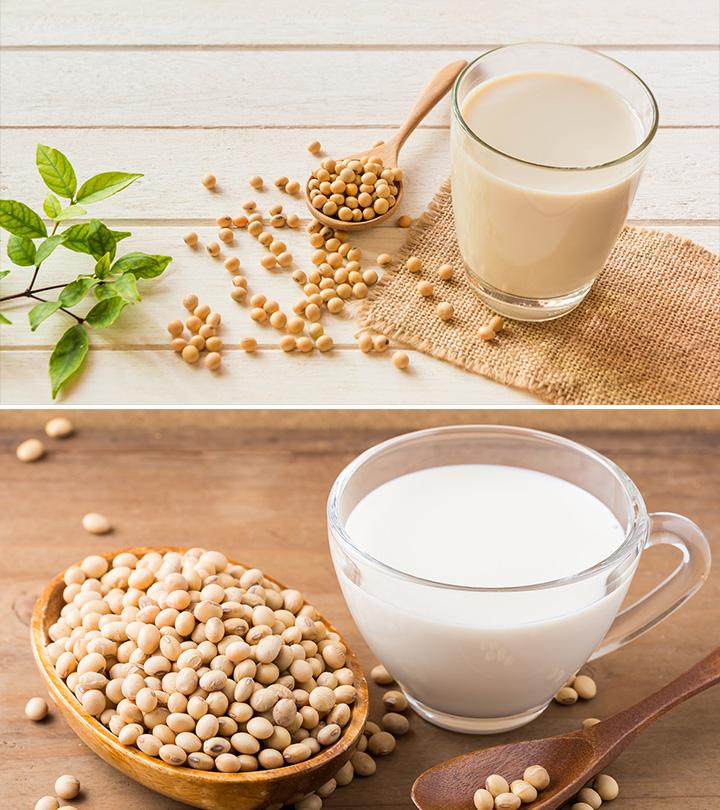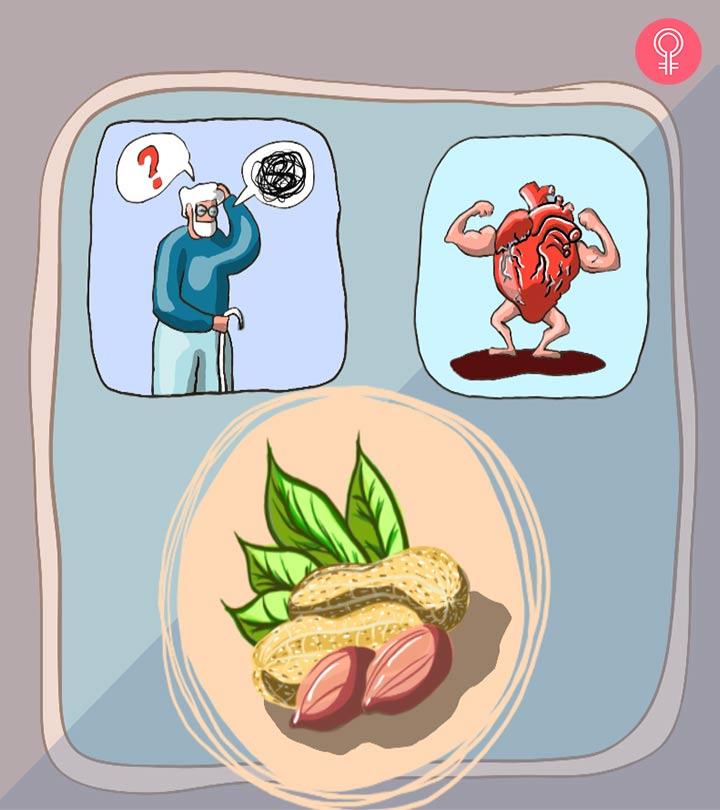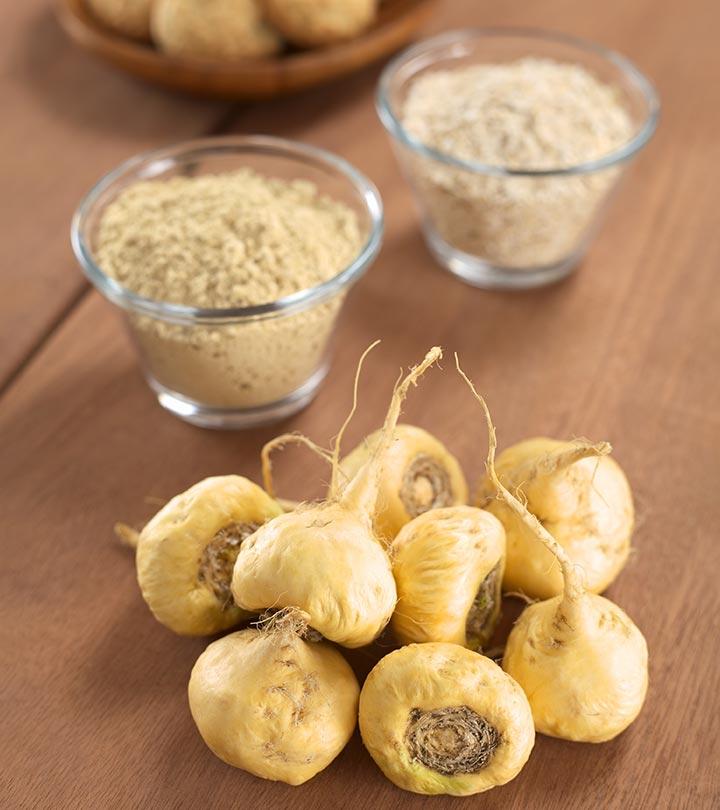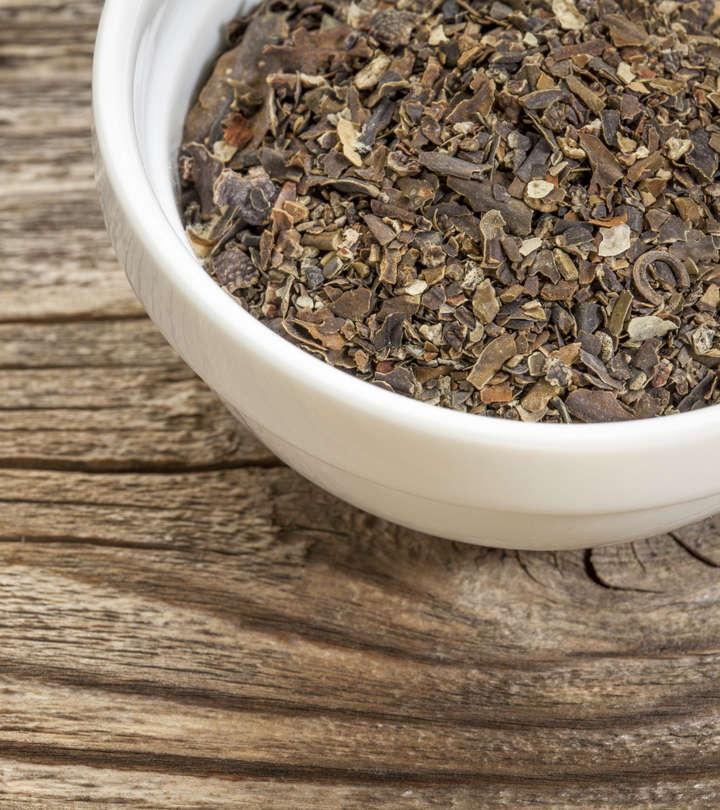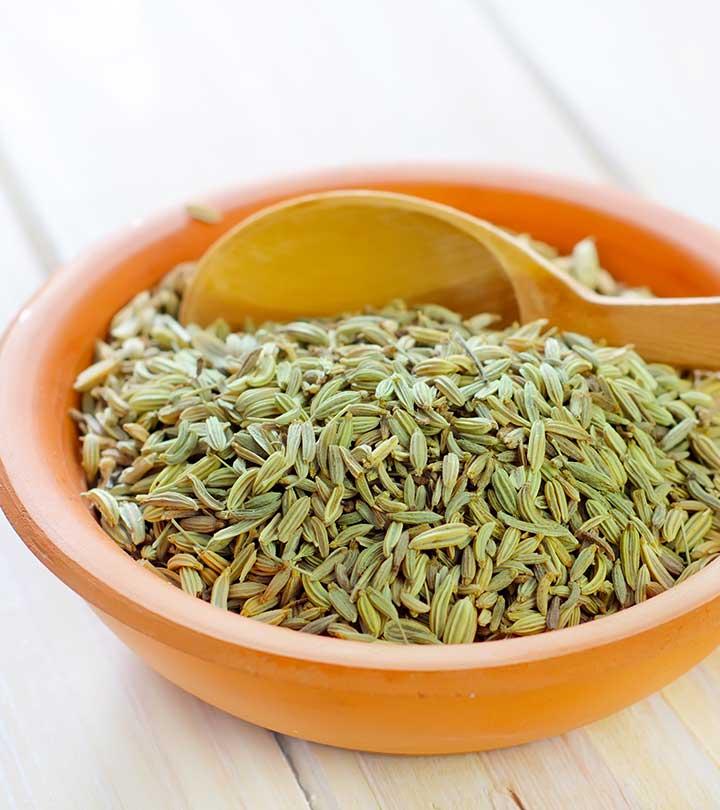13 Benefits Of Mangoes, Nutrition, Recipes, & Side Effects
The king of fruits is just as great for your health as it is for your tastebuds!

Image: Shutterstock
Mangoes, also known as the king of fruits, are loved by many for their sweet taste. The benefits of mangoes can be attributed to their nutrient-rich profile. These fruits have been cultivated for centuries and are native to southeast Asia. They belong to the drupe family. Mangoes are one of the most nutrient-dense fruits and contain 20 different vitamins and minerals. They are available in different colors and varieties.
Mangoes may improve immunity, reduce the risk of different types of cancer, enhance digestive health, reduce the risk of cardiovascular diseases, improve digestion, and enhance vision. All these can be attributed to their rich antioxidant content.
Learn more about these tasty fruits and the benefits they offer from the article below. Scroll down to read further!
 Know Your Ingredient: Mango
Know Your Ingredient: MangoWhat Is It?
Sweet and juicy tropical fruit of the Mangifera indica tree.
What Are Its Benefits?
Mangoes may reduce the risk of cardiovascular disease and cancer, treat anemia, promote liver and brain health, improve digestion, and enhance vision.
Who Can Use It?
Anyone except those who are sensitive to mangoes or have a mango latex allergy.
How Often?
You can consume mangoes daily and use them as a part of your skin care routine to fetch maximum benefits.
Caution
Excess consumption of mangoes may cause a spike in blood sugar levels, extreme irritation, diarrhea, and contact dermatitis. Practice caution and limit intake to avoid allergic reactions and side effects.
In This Article
Nutritional Information Of Mangoes
Mango is a nutritious and juicy fruit, and it is a good source of various vitamins and minerals. According to the United States Department of Agriculture (USDA), one cup (165 g) of sliced mango contains (1):
Energy – 99 kcal
Protein – 1.35 g
Carbohydrate – 24.7 g
Dietary Fiber – 2.64 g
Fat – 0.627 g
Sugars – 22.5 g
Folate – 71 mcg
Vitamin C – 60.1 mcg
Calcium – 1.2 mg
Iron – 0.264 mg
Sodium – 1.65 mg
Potassium – 277 mg
The fruit also contains nutrients such as vitamin A, riboflavini A type of vitamin B that is water soluble and not stored in the body. They are discarded through urination. , niacin, magnesium, manganese, and phosphorus.
In the next section, we will look at the health benefits of mangoes.
Health Benefits Of Mangoes
1. May Improve Immunity
Mangoes are a rich source of essential vitamins that boost immunity. The fruit contains vitamin C. This nutrient possesses antioxidant properties that may improve immune health (2), (3).
A study conducted by Hohenheim University found that mangoes are rich in beta-carotene, which is a carotenoid that helps enhance the immune system (4), (5).
Vitamin A is another important nutrient in mangoes that boosts immunity. This vitamin may fight against infectious diseases (6), (7).
2. May Reduce The Risk Of Heart Disease
Including mangoes in a balanced diet could help reduce body fat and control blood sugar levels. This fruit offers potassium and magnesium that may reduce the risk of heart disease.
A study conducted by the RWTH Aachen University found that intake of magnesium may improve heart health (8). Potassium acts as a vasodilator. It may help reduce stress on the blood vessels and promote cardiac function (9).
Mangoes are a rich source of beta-carotene. Carotenoids may reduce heart disease risk by preventing the oxidation of cholesterol in the arteries (10).
Mangoes are also rich in another compound named mangiferin. As per a study conducted by the University of Madras, mangiferin lowered the cholesterol levels in lab rats (11).
Mangiferin supplementation was also found to increase the levels of HDL (high-density lipoprotein), the good cholesterol (12).
3. May Improve Digestive Health
Mangoes contain digestive enzymes like amylases. These break down complex carbohydrates into simple sugars (13). This may help improve the digestive process, though more research is warranted in this aspect. A study conducted by the Texas A&M University found that the polyphenols in mangoes may relieve the symptoms of constipation (14).
4. May Support Eye Health
The vitamin A and beta-carotene in mangoes may help boost eye health. The severest cases of vitamin A deficiency can even lead to blindness. Vitamin A improves eye health and vision. Specifically speaking, the vitamin is essential for the optimal functioning of the cornea (15).
The human eye has two major carotenoids such as lutein and zeaxanthin. Fruits of various colors, in general (including mangoes) are a rich source of zeaxanthin and invariably help improve eye health (16), (17). Mangoes also contain lutein that promotes vision health (18).
According to a Boston study, cryptoxanthin (another carotenoid in mangoes) was found to reduce the risk of age-related macular degeneration in elderly Japanese (19).
5. May Reduce Cancer Risk
The pulp of the mango fruit contains carotenoids, ascorbic acid, terpenoids, and polyphenols that are said to possess cancer prevention properties (20). Mangoes are also found to contain unique antioxidants that are absent in other fruits and vegetables. A study conducted by Texas University found that the polyphenols in mangoes have anti-carcinogenic effects that may help decrease oxidative stress (oxidative stress can increase the risk of chronic diseases like cancer) (21).
The anticancer properties of mango are also attributed to mangiferin, a compound primarily found in the fruit (22). Another mice study conducted in 2015 found that mango polyphenols may suppress breast cancer (23). Mangiferin has also been found to inhibit the growth of colon and liver cancer cells (24).
A mouse study conducted by the Industrial Toxicology Research Centre found that lupeol, a triterpene found in mangoes, may help fight against prostate cancer (25). In animal studies, the polyphenolics found in mangoes were also found to suppress tumor growth in breast cancer (26).
6. May Help Treat Diabetes
Eating mangoes may help treat diabetes. A study of 20 obese adults showed that the consumption of half a fresh mango for 12 weeks results in lowered blood glucose levels (27).
Another study conducted by the Central Food Technological Research Institute proved that the extract of a mango peel has antidiabetic properties (28). Another study conducted by the Suzuka University of Medical Science showed that the mangiferin in mangoes may have beneficial effects in those with type 2 diabetes (29).
7. May Treat Anemia
Mangoes contain iron. They may help individuals and pregnant women with anemia when taken along with other iron-rich foods (30), (31), (32).
The vitamin C in mangoes can help with the proper absorption of iron in the body (33).
8. May Promote Brain Health
Mangoes contain vitamin B6. When taken along with other foods rich in vitamin B6, it may promote brain health. Some research shows that vitamin B6 deficiency could increase the risk of depression and seizures (34). Hence, mangoes can work as a mood enhancer and provide an energy boost.
A mice study conducted by the Ram-Eesh Institute of Vocational and Technical Education proved that mango extracts contain certain principles that may enhance memory (35). Another Thailand study stated that mango extracts may protect against mild cognitive impairment (36).
However, we need more studies to further understand the cognitive benefits of mangoes.
9. May Help Lower Cholesterol
In a study conducted by the University of Madras, the mangiferin in mangoes was found to lower the cholesterol levels in lab rats (12).
It was also found to increase the levels of HDL (high-density lipoprotein), the good cholesterol (27).
10. May Aid Weight Loss
A study had emphasized the importance of the mango peel (which most of us usually throw away) in inhibiting adipogenesis, or the formation of fat cells (37). This may help with weight loss if coupled with the right diet and lifestyle changes.
Mangoes contain fiber and may potentially help with weight management. In a University of Minnesota study, it was proved that dietary fiber, especially obtained from the consumption of fruits and vegetables, may aid weight loss (38). This is related to the ability of fiber to decrease food intake in general.
11. May Promote Liver Health
Consumption of mangoes may enhance liver function (39). Some anecdotal evidence suggests that unripe mangoes may help in treating liver disorders. However, research is very limited to prove this claim.
12. May Enhance Skin Health
A study conducted by the Korea Institute of Oriental Medicine found that mango extracts may act against UVB-induced skin aging in mice (40).
As already discussed, mangoes are rich in beta-carotene and vitamin A. As per a German study, these carotenoids can help enrich skin health (41). Beta-carotene is also a photoprotective agent that is thought to quench the photochemical reactions in the epidermis, thereby protecting the skin from the ultraviolet rays (42).
According to a Chinese study, the polyphenols in mangoes exhibit anticancer activity. They may help reduce the risk of skin cancer (43). Some anecdotal evidence suggests that mangoes may also prevent the growth of pimples and acne.
13. May Improve Hair Health
Mangoes are a rich source of vitamin A that may improve hair health. In mice studies, dietary vitamin A could activate the hair follicles (44). This, in turn, may improve the sebum (liquid that moisturizes scalp) production and promote scalp health (45).
Mangoes are also rich in polyphenols that help fight oxidative stress. Oxidative stress may have detrimental effects on hair health (46).
 Quick Tip
Quick TipThese are the various health benefits of mango. In the following section, we have discussed how you can buy mangoes and store them the right way.
How To Buy And Store Mangoes
Buying
Mangoes are available in large amounts during the peak season, and you might be tempted to buy a boxful when they are available at a reasonable price. It is important to know how to pick the right mango.
You should know that mangoes should be selected by their aroma and not by their color (the color varies from variety to variety). Their aroma should be distinct and ripe.
- While buying mangoes, choose the ones without dark spots, blemishes, or splits.
- Fresh mangoes, on average, measure about four inches in length and weigh about nine ounces to four pounds each.
- Though unripe mangoes are green, and ripe mangoes have colors ranging from yellow or orange to red, color is not always an indication of maturity. There are some varieties where ripe mangoes retain their green color. Hence, avoid mangoes that have no fragrant aroma.
- Never choose under-ripe mangoes as they have an unpleasant taste when eaten raw (unless you like the peculiar taste). A ripe mango generally has a full fruity aroma emitting from the stem end, is soft to touch, and yields to gentle pressure.
Storage
Proper storage is necessary to ensure the fruit stays fresh. Storing a particular fruit is totally dependent on its type and other conditions.
- Mangoes generally have a shelf life of one to two weeks and can be refrigerated for up to three days.
- If the mangoes are hard and green, they should be placed in a brown paper bag for a few days for them to ripen. They should be stored at the room temperature and away from the sun until they ripen. Once ripe, they can be stored in the refrigerator.
- Mangoes can also be frozen. Freezing them makes their skin black, but the inner flesh stays in a good condition.
- They can be frozen as whole fruits or as chopped pieces. When freezing peeled mangoes, sprinkle sugar over the chopped fruit and stir gently with a wooden spoon to dissolve the sugar in the fruit’s own juices. Seal these pieces in an airtight container (leaving a ½ inch airspace) or in plastic freezer bags after squeezing all the air out.
Mangoes are also used in cooking many delicious dishes. Check out the tasty recipes below!
Recipes
Just in case eating mangoes the usual way seems too monotonous, we have something for you. A couple of delectable mango recipes that are easy to make but hard to live without!
1. Mango Tango Black Bean Salsa
What You Need
- 1 mango
- 1 can of black beans, drained and rinsed
- 1 can of kernel corn with peppers, drained
- Finely chopped onions, ½ cup
- Fresh and coarsely chopped cilantro, ½ cup
- Lime juice, 2 tablespoons
- Garlic salt, 1 teaspoon
- Ground cumin, ¼ teaspoon
Directions
- Wash and peel the mango. Cut it lengthwise. Remove the seed and cut the fruit into ¾ inch cubes.
- Combine all the ingredients in a medium bowl and mix well.
- Refrigerate and serve.
2. Mango-Oat Milkshake
What You Need
- The pulp of 1 mango
- Oat flakes, 2 tablespoons
- Honey, 1 tablespoon
- Milk, 200 ml
Directions
- Mix the ingredients in a blender. Refrigerate and drink.
 Quick Tip
Quick TipWe have seen the many benefits of mangoes and how to use them. Let’s check a few facts about mangoes in the following section.
Facts About Mangoes
- Mango is known throughout the world as the king of fruits.
- Mangoes had originated in East India, the Andaman Islands, and Burma. Today they are popular across the world. It is believed the Buddhist monks had introduced the fruit to Malaysia and Eastern Asia in the 5th
- India is the leading producer of mangoes. But it has very little export as most of the produce is consumed within the country.
- Mango trees can grow very tall, some as much as 100 feet. More interestingly, mango trees can bear fruit for up to 300 years.
- There are about 400 varieties of mangoes in the world today.
Mangoes could cause a few side effects. We have discussed them in the following section.
What Are The Side Effects Of Mangoes?
Consumption of mangoes is generally considered safe. However, some may be sensitive to mangoes that may cause allergies and contact dermatitisi A broad term used to refer to various common types of skin irritation. Symptoms include dryness, itchiness, and rashes. . Also, intake of too many mangoes may cause side effects, such as diarrhea and an increase in blood sugar levels. However, research is very limited in this regard.
May Cause Allergies
Certain individuals were found to be allergic to mangoes. These allergies include contact dermatitis, food hypersensitivityi A term used for unwanted reactions by the immune system that are exaggerated and create discomfort. , etc. They are associated with a condition called the mango latex allergy. It also can cause extreme irritation at the angles of the mouth, lips, and the tip of the tongue (47).
Mangoes contain a small amount of urushiol, which is a toxic resin that may cause dermatitis (48).
Miri, a blogger, developed a mango allergy despite having a profound love for the fruit. She reported that the urushiol in mango sap led to the painful bumps and blisters on her skin. She adds, “Unfortunately for me, urushiol is also present in (and sometimes on) the mango’s skin. When preparing the fruit, extreme care has to be taken so as not to transfer any sap onto the fruit itself (or onto oneself). My slightly puffy lips suggest that I have NOT been careful enough in removal of all present sap before cutting the fruit or have been cutting the fruit too close to the skin (i).”
Infographic: Mango An Overview
Mangoes are delightful tropical fruits packed with many beneficial nutrients. They are tasty and sweet and provide a number of health benefits.
Learn more from the infographic below about their global appeal, the many varieties of mangoes available on the US markets, and some interesting ways of using them to rejuvenate your skin. Illustration: StyleCraze Design Team
Eating mango benefits your health in numerous ways due to its high antioxidant levels. Intake of mangoes may improve immunity, reduce the risk of heart disease, and enhance digestive health. In addition, the carotenoidsi Pigments found in plants, algae, and microbes responsible for bright yellow, red, and orange hues in vegetables and fruits. in mangoes may support eye health. However, overconsumption of mangoes may cause diarrhea and allergies. Hence, practice moderation – and avoid eating mangoes if you are sensitive to them.
Frequently Asked Questions
What are the different types of a mango?
There are close to 400 varieties of mango across the world. Here are a few of the most popular ones in India, which is the largest producer of the fruit.
Banganapalli – Available from April to June and originating in Andhra Pradesh.
Pairi – Available from May to June and originating in Gujarat.
Alphonso – Available from May to June and originating in Maharashtra.
Himsagar – Available in May and originating in West Bengal.
Neelam – Available from May to July and a favorite in Hyderabad.
Kesar – Available from June to early July and originating in Gujarat.
Totapuri – Available from June to July and native to Andhra Pradesh, Telangana, Tamil Nadu, and Karnataka.
Are mangoes good for dieting?
A half cup of sliced mangoes contains just about 50 calories. You can replace any of your high-calorie snacks with a mango. It fills your stomach and curbs your hunger.
More importantly, mangoes are a rich source of fiber that is known to aid digestion and keep you feeling full for longer periods. Hence, if you are dieting, mangoes can be a very good addition.
How to slice a mango?
The right way to slice a mango is to find the eye (the seed runs directly behind it) and the cheeks. Place a mango on the cutting board, such that it is looking up at you. Make a cut off the center, about half an inch from the edge. Turn the mango around and cut the other side. Now you have the two cheeks. Take one cheek and cut through the flesh, making parallel spears. Repeat with the other mango cheek.
How to ripen mangoes?
There are a few tricks that can help.
You can place the mango inside a paper bag and leave it on the kitchen counter overnight. The fruit releases ethylene, an odorless gas that accelerates the ripening process. But ensure you don’t close the bag completely – there must be a way for the air and gas to escape to keep mold from forming.
You can also submerge the mango in a bowl of uncooked rice. Rice helps trap the released ethylene gas and accelerates ripening.
Can babies have mangoes?
Yes, mangoes are safe for babies. They aid digestion and even build the baby’s immunity. They also promote brain development.
However, there are certain allergy concerns with mango skin. One allergy, according to certain experts, can be found in the form of a diaper rash in the baby.
Peeling the mango completely before feeding it to your baby is the ideal solution. You can also mash the fruit and add it to the baby’s food.
Are mangoes high on sugar?
A half cup of diced mango contains about 70 calories, most of which come from sugar. Yes, mangoes are high on sugar (roughly about 31 grams per mango). Mangoes may not affect your blood sugar levels as they contain natural sugars. However, if you are required to limit your sugar intake, consult a doctor before taking mangoes.
The advantage is that the sweetness of mangoes may keep you from craving other unhealthy sweets.
What fruits does a mango go well with?
The fruit goes well with bananas. If you are preparing a smoothie, this combination works wonders. Mango also goes well with coconut, orange, and pineapple.
Can you eat mango peel?
As we have already discussed, the peel contains essential nutrients. It may taste bitter, but it contains healthful compounds like mangiferin. Hence, you can eat the mango peel.
However, if you happen to develop a reaction to mango skin, refrain from eating the peel. Certain individuals develop allergies around their mouths when they consume the peel.
How to peel a mango?
You can peel a mango with a knife. Make a shallow cut under the skin and slice off a thin strip. Repeat the process on the entire body of the mango.
You can also use a vegetable peeler. Place the mango on a cutting board and peel off the skin.
You can even use your hands to peel the fruit. Simply find the stem of the ripe fruit, and slowly remove a section of the peel around the area. Repeat the process until you have peeled the entire fruit.
Is eating a mango at night bad?
No, you can eat a mango during the night.
Key Takeaways
- Mangoes offer numerous benefits due to their high antioxidant levels.
- The high fiber content in mangoes may help improve digestion and prevent constipation.
- Its potassium and magnesium content promotes heart health.
- Mangoes may lower the risk of cancer by decreasing oxidative stress with the help of carotenoids, ascorbic acid, and polyphenols present in the pulp.
- Excess consumption of mango may cause diarrhea and increase blood sugar levels.
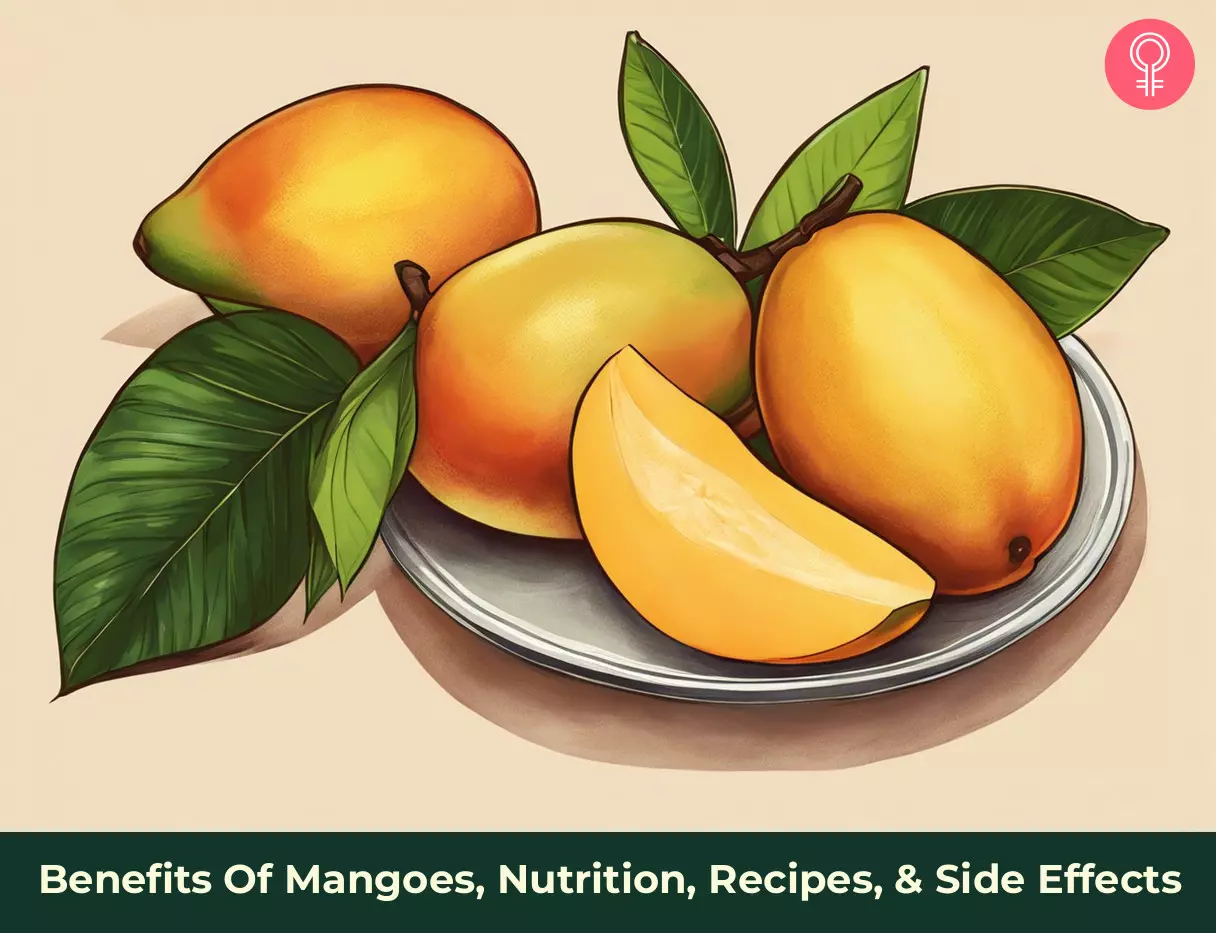
Image: Stable Diffusion/StyleCraze Design Team
References
Articles on StyleCraze are backed by verified information from peer-reviewed and academic research papers, reputed organizations, research institutions, and medical associations to ensure accuracy and relevance. Read our editorial policy to learn more.
- “FoodData Central Search Results.” FoodData Central.
https://fdc.nal.usda.gov/fdc-app.html#/food-details/169910/nutrients - Carr AC, Maggini S. Vitamin C and Immune Function. Nutrients. 2017;9(11):1211. Published 2017 Nov 3.
https://pubmed.ncbi.nlm.nih.gov/29099763/ - Huijskens MJ, Walczak M, Koller N, et al. Technical advance: ascorbic acid induces development of double-positive T cells from human hematopoietic stem cells in the absence of stromal cells. J Leukoc Biol. 2014;96(6):1165–1175.
https://pubmed.ncbi.nlm.nih.gov/25157026/ - Pott I, Marx M, Neidhart S, Mühlbauer W, Carle R. Quantitative determination of beta-carotene stereoisomers in fresh, dried, and solar-dried mangoes (Mangifera indica L.). J Agric Food Chem. 2003;51(16):4527–4531.
https://pubmed.ncbi.nlm.nih.gov/14705872/ - Hughes DA. Effects of carotenoids on human immune function. Proc Nutr Soc. 1999;58(3):713–718.
https://pubmed.ncbi.nlm.nih.gov/10604207/ - Veldhoen M, Ferreira C. Influence of nutrient-derived metabolites on lymphocyte immunity. Nat Med. 2015;21(7):709–718.
https://pubmed.ncbi.nlm.nih.gov/26121194/ - Yang Y, Yuan Y, Tao Y, Wang W. Effects of vitamin A deficiency on mucosal immunity and response to intestinal infection in rats. Nutrition. 2011;27(2):227–232.
https://pubmed.ncbi.nlm.nih.gov/20363594/ - Jahnen-Dechent W, Ketteler M. Magnesium basics. Clin Kidney J. 2012;5(Suppl 1):i3–i14.
https://pubmed.ncbi.nlm.nih.gov/26069819/ - Khan E, Spiers C, Khan M. The heart and potassium: a banana republic. Acute Card Care. 2013;15(1):17–24.
https://pubmed.ncbi.nlm.nih.gov/23425010/ - Voutilainen S, Nurmi T, Mursu J, Rissanen TH. Carotenoids and cardiovascular health. Am J Clin Nutr. 2006;83(6):1265–1271.
https://pubmed.ncbi.nlm.nih.gov/16762935/ - 11. Nair PS, Shyamala Devi CS. Efficacy of mangiferin on serum and heart tissue lipids in rats subjected to isoproterenol induced cardiotoxicity. Toxicology. 2006;228(2-3):135–139.
https://pubmed.ncbi.nlm.nih.gov/17052832/ - Na L, Zhang Q, Jiang S, et al. Mangiferin supplementation improves serum lipid profiles in overweight patients with hyperlipidemia: a double-blind randomized controlled trial. Sci Rep. 2015;5:10344. Published 2015 May 19.
https://pubmed.ncbi.nlm.nih.gov/25989216/ - Peroni FH, Koike C, Louro RP, et al. Mango starch degradation. II. The binding of alpha-amylase and beta-amylase to the starch granule. J Agric Food Chem. 2008;56(16):7416–7421.
https://pubmed.ncbi.nlm.nih.gov/18656927/ - Venancio VP, Kim H, Sirven MA, et al. Polyphenol-rich Mango (Mangifera indica L.) Ameliorate Functional Constipation Symptoms in Humans beyond Equivalent Amount of Fiber. Mol Nutr Food Res. 2018;62(12):e1701034.
https://pubmed.ncbi.nlm.nih.gov/29733520/ - Gilbert, Clare. “The eye signs of vitamin A deficiency.” Community eye health vol. 26,84 (2013): 66-7.
https://www.ncbi.nlm.nih.gov/pmc/articles/PMC3936686/ - Sommerburg, O et al. “Fruits and vegetables that are sources for lutein and zeaxanthin: the macular pigment in human eyes.” The British journal of ophthalmology vol. 82,8 (1998): 907-10.
https://www.ncbi.nlm.nih.gov/pmc/articles/PMC1722697/ - Eisenhauer B, Natoli S, Liew G, Flood VM. Lutein and Zeaxanthin-Food Sources, Bioavailability and Dietary Variety in Age-Related Macular Degeneration Protection. Nutrients. 2017;9(2):120. Published 2017 Feb 9.
https://pubmed.ncbi.nlm.nih.gov/28208784/ - Nasri, Hamid et al. “New concepts in nutraceuticals as alternative for pharmaceuticals.” International journal of preventive medicine vol. 5,12 (2014): 1487-99.
https://www.ncbi.nlm.nih.gov/pmc/articles/PMC4336979/ - Schleicher, Molly et al. “Diminishing risk for age-related macular degeneration with nutrition: a current view.” Nutrientsvol. 5,7 2405-56. 2 Jul. 2013.
https://www.ncbi.nlm.nih.gov/pmc/articles/PMC3738980/ - Corrales-Bernal A, Amparo Urango L, Rojano B, Maldonado ME. Efectos in vitro e in vivo de la pulpa de mango (Mangifera indica cv. Azúcar) en la carcinogénesis de colon] [In vitro and in vivo effects of mango pulp (Mangifera indica cv. Azucar) in colon carcinogenesis]. Arch Latinoam Nutr. 2014;64(1):16–23.
https://pubmed.ncbi.nlm.nih.gov/25796713/ - Noratto GD, Bertoldi MC, Krenek K, Talcott ST, Stringheta PC, Mertens-Talcott SU. Anticarcinogenic effects of polyphenolics from mango (Mangifera indica) varieties. J Agric Food Chem. 2010;58(7):4104–4112.
https://pubmed.ncbi.nlm.nih.gov/20205391/ - Gold-Smith, Fuchsia et al. “Mangiferin and Cancer: Mechanisms of Action.” Nutrients vol. 8,7 396. 28 Jun. 2016.
https://www.ncbi.nlm.nih.gov/pmc/articles/PMC4963872/ - Banerjee N, Kim H, Krenek K, Talcott ST, Mertens-Talcott SU. Mango polyphenolics suppressed tumor growth in breast cancer xenografts in mice: role of the PI3K/AKT pathway and associated microRNAs. Nutr Res. 2015;35(8):744–751.
https://pubmed.ncbi.nlm.nih.gov/26194618/ - Li, Minglin et al. “Mangiferin inhibition of proliferation and induction of apoptosis in human prostate cancer cells is correlated with downregulation of B-cell lymphoma-2 and upregulation of microRNA-182.” Oncology letters vol. 11,1 (2016): 817-822.
https://www.ncbi.nlm.nih.gov/pmc/articles/PMC4726971/ - Prasad S, Kalra N, Shukla Y. Induction of apoptosis by lupeol and mango extract in mouse prostate and LNCaP cells. Nutr Cancer. 2008;60(1):120–130.
https://pubmed.ncbi.nlm.nih.gov/18444143/ - Banerjee N, Kim H, Krenek K, Talcott ST, Mertens-Talcott SU. Mango polyphenolics suppressed tumor growth in breast cancer xenografts in mice: role of the PI3K/AKT pathway and associated microRNAs. Nutr Res. 2015;35(8):744–751.
https://pubmed.ncbi.nlm.nih.gov/26194618/ - Evans, Shirley F et al. “Mango supplementation improves blood glucose in obese individuals.” Nutrition and metabolic insights vol. 7 77-84. 28 Aug. 2014.
https://www.ncbi.nlm.nih.gov/pmc/articles/PMC4155986/ - Gondi M, Prasada Rao UJ. Ethanol extract of mango (Mangifera indica L.) peel inhibits α-amylase and α-glucosidase activities, and ameliorates diabetes related biochemical parameters in streptozotocin (STZ)-induced diabetic rats. J Food Sci Technol. 2015;52(12):7883–7893.
https://pubmed.ncbi.nlm.nih.gov/26604360/ - Miura T, Iwamoto N, Kato M, et al. The suppressive effect of mangiferin with exercise on blood lipids in type 2 diabetes. Biol Pharm Bull. 2001;24(9):1091–1092.
https://pubmed.ncbi.nlm.nih.gov/11558577/ - Ballot D, Baynes RD, Bothwell TH, et al. The effects of fruit juices and fruits on the absorption of iron from a rice meal. Br J Nutr. 1987;57(3):331–343.
https://pubmed.ncbi.nlm.nih.gov/3593665/ - Miller, Jeffery L. “Iron deficiency anemia: a common and curable disease.” Cold Spring Harbor perspectives in medicine vol. 3,7 a011866. 1 Jul. 2013.
https://www.ncbi.nlm.nih.gov/pmc/articles/PMC3685880/ - Shah, K A et al. “Mangifera indica (mango).” Pharmacognosy reviews vol. 4,7 (2010): 42-8.
https://www.ncbi.nlm.nih.gov/pmc/articles/PMC3249901/ - Lynch SR, Cook JD. Interaction of vitamin C and iron. Ann N Y Acad Sci. 1980;355:32–44.
https://pubmed.ncbi.nlm.nih.gov/6940487/ - Malouf R, Grimley Evans J. The effect of vitamin B6 on cognition. Cochrane Database Syst Rev. 2003;(4):CD004393.
https://pubmed.ncbi.nlm.nih.gov/14584010/ - Kumar S, Maheshwari KK, Singh V. Effects of Mangifera indica fruit extract on cognitive deficits in mice. J Environ Biol. 2009;30(4):563–566.
https://pubmed.ncbi.nlm.nih.gov/20120497/ - Wattanathorn, Jintanaporn et al. “Mangifera indica fruit extract improves memory impairment, cholinergic dysfunction, and oxidative stress damage in animal model of mild cognitive impairment.” Oxidative medicine and cellular longevity vol. 2014 (2014): 132097.
https://www.ncbi.nlm.nih.gov/pmc/articles/PMC3941952/ - Taing MW, Pierson JT, Hoang VL, et al. Mango fruit peel and flesh extracts affect adipogenesis in 3T3-L1 cells. Food Funct. 2012;3(8):828–836.
https://pubmed.ncbi.nlm.nih.gov/22699857/ - Slavin JL. Dietary fiber and body weight. Nutrition. 2005;21(3):411–418.
https://pubmed.ncbi.nlm.nih.gov/15797686/ - Guan, Yong-Song, and Qing He. “Plants Consumption and Liver Health.” Evidence-based complementary and alternative medicine : eCAM vol. 2015 (2015): 824185.
https://www.ncbi.nlm.nih.gov/pmc/articles/PMC4499388/ - Song JH, Bae EY, Choi G, et al. Protective effect of mango (Mangifera indica L.) against UVB-induced skin aging in hairless mice. Photodermatol Photoimmunol Photomed. 2013;29(2):84–89.
https://pubmed.ncbi.nlm.nih.gov/23458392/ - Schagen, Silke K et al. “Discovering the link between nutrition and skin aging.” Dermato-endocrinology vol. 4,3 (2012): 298-307.
https://www.ncbi.nlm.nih.gov/pmc/articles/PMC3583891/ - Evans, Julie A, and Elizabeth J Johnson. “The role of phytonutrients in skin health.” Nutrients vol. 2,8 (2010): 903-28.
https://www.ncbi.nlm.nih.gov/pmc/articles/PMC3257702/ - Li, An-Na et al. “Resources and biological activities of natural polyphenols.” Nutrients vol. 6,12 6020-47. 22 Dec. 2014.
https://www.ncbi.nlm.nih.gov/pmc/articles/PMC4277013/ - Suo L, Sundberg JP, Everts HB. Dietary vitamin A regulates wingless-related MMTV integration site signaling to alter the hair cycle. Exp Biol Med (Maywood). 2015;240(5):618–623.
https://pubmed.ncbi.nlm.nih.gov/25361771/ - Everts HB. Endogenous retinoids in the hair follicle and sebaceous gland. Biochim Biophys Acta. 2012;1821(1):222–229.
https://pubmed.ncbi.nlm.nih.gov/21914489/ - Trüeb RM. The impact of oxidative stress on hair. Int J Cosmet Sci. 2015;37 Suppl 2:25–30.
https://pubmed.ncbi.nlm.nih.gov/26574302/ - Sareen, Richa, and Ashok Shah. “Hypersensitivity manifestations to the fruit mango.” Asia Pacific allergy vol. 1,1 (2011): 43-9.
https://www.ncbi.nlm.nih.gov/pmc/articles/PMC3206236/ - Oka K, Saito F, Yasuhara T, Sugimoto A. A study of cross-reactions between mango contact allergens and urushiol. Contact Dermatitis. 2004;51(5-6):292–296.
https://pubmed.ncbi.nlm.nih.gov/15606656/
Read full bio of Ariana Fiorita
Read full bio of Ravi Teja Tadimalla
Read full bio of Aparna Mallampalli















